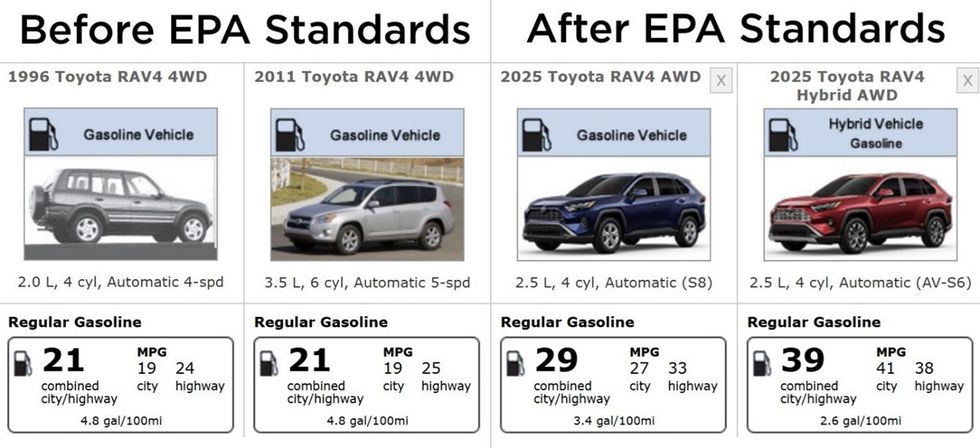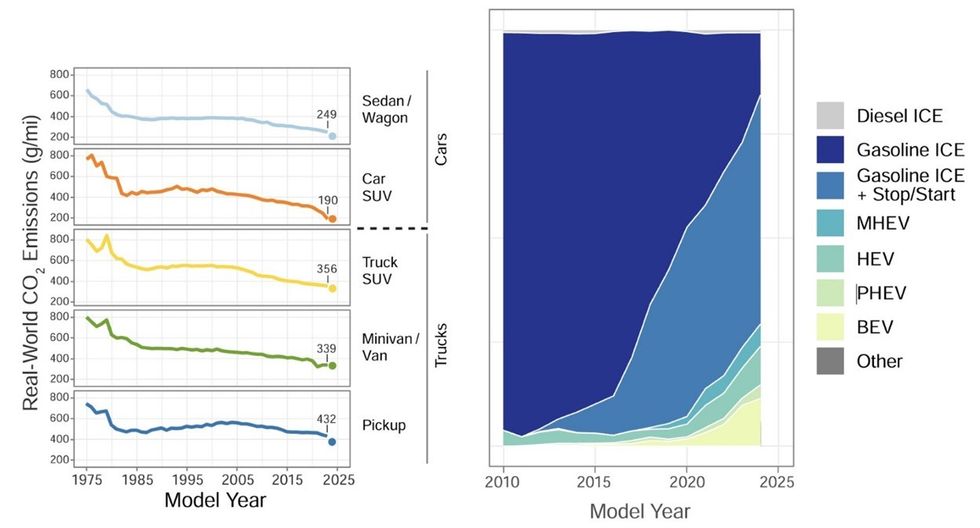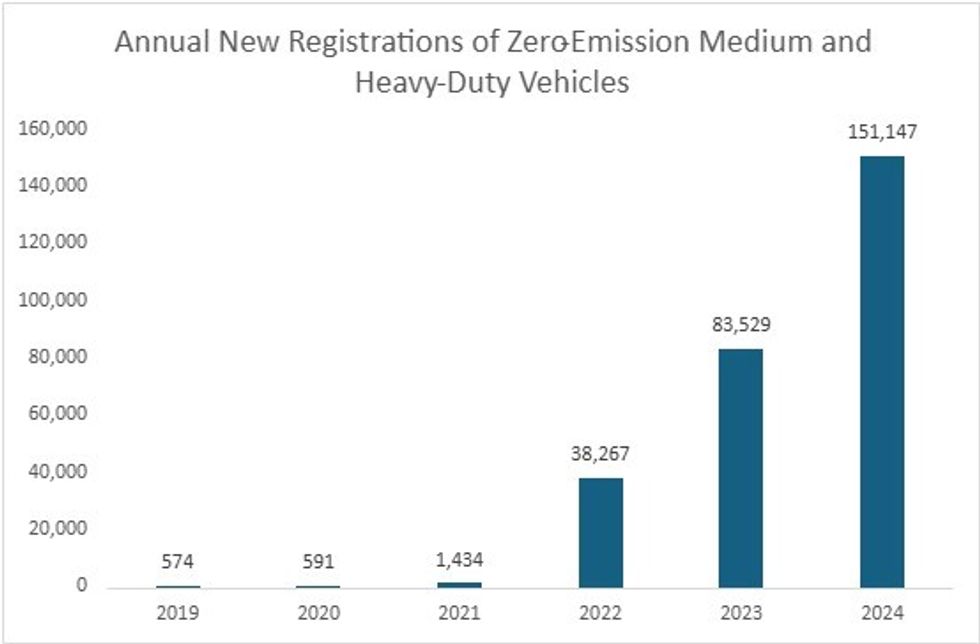

SUBSCRIBE TO OUR FREE NEWSLETTER
Daily news & progressive opinion—funded by the people, not the corporations—delivered straight to your inbox.
5
#000000
#FFFFFF
To donate by check, phone, or other method, see our More Ways to Give page.


Daily news & progressive opinion—funded by the people, not the corporations—delivered straight to your inbox.
Instead of continuing past success on reducing emissions, lowering consumer costs, and helping American automakers lead the global transition to clean vehicles, the Trump administration has moved to eliminate EPA actions that reduce climate pollution.
The Trump administration’s “Freedom to Pollute” agenda just went into overdrive.
The 2009 endangerment finding on climate emissions is the underlying basis for the Environmental Protection Agency’s (EPA) regulatory responsibility for taking actions to address greenhouse gas pollution. U.S. President Donald Trump’s EPA just proposed to eliminate this science-backed finding which puts several rules, and their many health, climate, and consumer benefits, at risk. Among these rules are the wildly successful vehicle standards that are reducing pollution, saving drivers money at the pump, driving industry innovation, and providing more clean vehicle choices at the dealerships than ever before.
This action flies in the face of overwhelming evidence of climate harms and the legal basis for the determination, as my colleague Dr. Cleetus pointed out in her blog when EPA Administrator Lee Zeldin first noted his interest in targeting the finding. This, like so many other recent administrative actions, will be challenged in court and may eventually be determined to be illegal, as it most certainly is.
Congress established EPA to protect public health and welfare—and since climate change pollution is clearly endangering these things, EPA has a responsibility to do something about it. By eliminating the endangerment finding, EPA is trying to avoid its responsibility to act. This isn’t just bad news for reducing climate emissions and the worsening impacts of climate change that Americans are dealing with on a daily basis from intensified storms to extreme heat, but it’s going to mean spending more at the pump and fewer choices at the dealership.
Transportation—including the cars, trucks, and buses plying our roads everyday—is the LARGEST source of human-caused climate pollution in the U.S. accounting for 28% of the annual total. And globally, the U.S. is second only to China in overall annual climate pollution. So yes—our cars and trucks and the gasoline and diesel they burn DO contribute to climate change. And reducing those emissions is important for getting global emissions—and global temperatures—under control.
I don’t know anyone who wants to spend thousands of dollars more on gas—but that’s the path we are headed down by eliminating standards.
Alongside the endangerment finding action, the administration also announced it was eliminating all EPA vehicle greenhouse gas standards for passenger cars and heavy-duty trucks. Despite the most recent passenger car and heavy-duty truck EPA standards regulations being less ambitious than our analysis suggested was feasible, they represent the largest climate action the U.S. has ever taken, Combined, the latest greenhouse gas standards for cars and heavy-duty trucks would eliminate a total of approximately 8 billion tons of heat-trapping emissions—more than one year of total U.S. climate emissions. EPA’s Draft Regulatory Impact Analysis, released alongside the announcement to eliminate the standards, completely ignores the value of these benefits noting, “The EPA does not attempt to monetize the value, if any, of changes in GHG emissions that result from the proposed action.” We’ll be taking a closer look at what other logical and analytical gymnastics the administration is including in their assessment as we prepare comments on the proposal.
History has shown that vehicle standards are extremely effective at reducing pollution. Smog-forming pollutants, carbon monoxide, and dangerous particulates from tailpipes have all declined substantially from the 1960s and ‘70s and led to improved air quality and public health. This progress on pollution, along with steadily growing vehicle sales, occurred despite constant cries from the auto industry over the past half a century claiming vehicle pollution standards were bad for business, unachievable, etc. etc. Vehicle standards have been an essential tool to achieving lower tailpipe emissions and more efficient gasoline models as well as bringing an ever-increasing variety of electrified models to market.

The proof is in the pudding. Take this chart from EPA’s latest “Trends Report.” While fuel economy standards accelerated emissions reductions after the oil crisis in the 70’s, in the absence of further regulation (resulting from automaker and oil industry opposition) the emissions from new vehicles rose in the 1990s and early 2000s. Why? Because contrary to what the EPA argues in its proposal, the market does not work to innovate and cut fuel in the absence of regulation. Over the last 20 years, new fuel economy and emissions standards, currently being eliminated by this administration, have pushed new vehicles to the lowest level of emissions on record.
The data don’t lie: Vehicle standards work. Freed from binding fuel economy and emission standards in 90’s and early 2000’s, vehicle pollution increased as well as gasoline consumption. Recent fuel economy and emissions standards being eliminated by this administration have pushed new vehicles to the lowest level of emissions on record.
When Trump offered to payback oil industry donations with political favors, I don’t think oil executives themselves could have even dreamed up that this wishlist would be granted within seven months of his reentering the White House.
This latest attack on vehicle standards specifically covers EPA’s greenhouse gas standards for cars and commercial medium and heavy-duty trucks. The first of these EPA standards went into effect in model year 2012 for passenger cars. The figure above illustrates the declining emissions that have occurred for the average vehicle since their implementation. But here’s a more specific illustrative example of what that means in the real world.
The Toyota RAV4 is the best-selling SUV in the U.S. Before EPA standards, it went 15 years with essentially zero improvement in fuel economy or emissions. Thanks to EPA standards, buyers now have options that are 29-46% more efficient. These more efficient options are saving consumers hundreds of dollars at the gas pump every year while cutting emissions in half for the cleanest models. I don’t know anyone who wants to spend thousands of dollars more on gas—but that’s the path we are headed down by eliminating standards.

EPA’s standards haven’t only delivered more choices of lower polluting, and less fuel consuming gasoline cars and trucks. These standards have pushed traditional vehicle makers to add more hybrid and electric vehicle models to their lineups and encouraged new EV-only companies to bring products to market. The increased availability of hybrid electric (HEV), plug-in hybrid electric (PHEV), and Battery Electric (BEV) models driven by vehicle standards (as shown in the figure below) has given consumers more choices to cut their gasoline bills or eliminate them all together.

Global warming emissions from new vehicles, no matter the type of vehicle, are at record lows, largely through the use of hybrid and plug-in electric technologies deployed by manufacturers in response to EPA standards, exactly the technologies that this administration is now attacking.
While the above examples are about passenger vehicles, the story is similar for the heavy-duty trucks. As pointed out in our report on electric truck progress, Ready for Work 2.0.
“A few years ago, electric vans, buses, and trucks were essentially concept vehicles—today, more than 70 models of zero-emission MHDVs are being put to work around the country thanks to investments spurred by EPA greenhouse gas emission standards and state zero-emission vehicle requirements.”
“The momentum behind zero-emission trucks has swelled over the past several years, with registrations of electric trucks reaching record levels each year. In 2019, there were fewer than 1,000 new zero-emission trucks, buses, and vans registered in the United States.”
Now there are 150,000 thousand electric medium and heavy-duty vehicles ranging from large pick-up trucks and delivery vans to a growing number of big rigs.

Reductions in heavy-duty truck emissions, fuel consumption, and the increasingly common sight of electric delivery trucks on our streets is no accident. It’s the result of policies like EPA’s vehicle standards.
Instead of trying to continue this success on reducing emissions, lowering consumer costs, and helping American automakers lead the global transition to clean vehicles, the Trump administration has moved to eliminate EPA actions that reduce climate pollution.
While some vehicle makers are guilty of fighting against state and federal vehicle standards so they can continue to wallow in global mediocrity, the oil industry is the one laughing all the way to the bank. For decades the oil industry has used fraud and deceit to avoid the realities of climate pollution, so it is no surprise they want to prolong the life of combustion vehicles as long as possible. They just scored big time in Trump’s tax bill, as my colleague details in their recent blog, and were already basking in the glow of Congress’ decision to pull the rug out from under the state clean car and truck standards and neutering the Department of Transportation’s fuel economy standards by eliminate compliance fines. Now they get another gift in in the elimination of EPA rules that would result in U.S. car and truck drivers spending billions more on gasoline and diesel than they would have otherwise. When Trump offered to payback oil industry donations with political favors, I don’t think oil executives themselves could have even dreamed up that this wishlist would be granted within seven months of his reentering the White House.
How much will the rest of us be paying to the oil industry, you ask? If all of these rollbacks take effect, there’s nothing stopping the auto industry from backsliding on the progress that’s been made. But just looking at the benefits of the rules that have yet to take effect gives a good idea. Owners of new passenger cars subject to the standards between 2027 and 2032 would have saved an estimated $6,000 over the life of the vehicle. Eliminating the Phase 3 heavy-duty truck GHG standards for model years 2027 through 2032 will increase net costs to truck drivers by $2 billion. These numbers are just the tip of the iceberg.
The attack on logic, reason, and just plain common sense might be comic, if it wasn’t so serious as pointed out in my colleagues “danger season” blog post. The irony of this past week’s extreme heat event impacting more than 150 million Americans happening at the same time as the administration’s latest climate-denial move was painfully apparent in this Fox News clip.
This is the time to accelerate, not throw us into reverse. Instead, the White House is seeking to trash these vital protections, using the flimsiest and most self-serving of rationales, showing yet again it is willing to sacrifice public protections for polluters’ gain. For U.S. drivers, it means less choices at the dealership and more pain at the pump.
"Instead of innovating, Toyota has bankrolled lobbyists and climate-hostile lawmakers to help it defeat EVs," according to Public Citizen.
Nearly three decades after its introduction, the hybrid Toyota Prius is still associated with environmental action and the scientific consensus that fossil fuel emissions, including those from vehicles, must be reduced to avoid the worst effects of planetary heating.
But a Tuesday report from watchdog group Public Citizen reveals how Toyota has spent recent years becoming the largest funder of U.S. lawmakers who deny the existence of the climate emergency, and a major opponent to the expansion of electric vehicles.
In the report, titled Driving Denial, senior clean vehicles campaigner Adam Zuckerman explains how Toyota has emerged over the last three election cycles as the auto industry's top financial backer of climate deniers in Congress—donating to 207 of their campaigners.
Top climate-denying beneficiaries of Toyota include U.S. House Speaker Mike Johnson (R-La.), who received $10,000 from Toyota in during the 2024 cycle—the maximum amount allowed—and Rep. Jason Smith (R-Mo.), who received $7,000 after he called for the end of EV tax credits and demanded the Environmental Protection Agency (EPA) be eliminated.
Between 2020-24, Toyota's political action committee (PAC) has contributed tens of thousands of dollars to right-wing lawmakers including Rep. James Comer (R-Ky.), David Schweikert (R-Ariz.) and Cathy McMorris Rodgers (R-Wash.)—giving a total of "$808,500 to the campaigns of congressional candidates that deny or question the existence of climate change," according to Public Citizen.
Despite Toyota's reputation as a hybrid car innovator, said Zuckerman, "the world's largest automaker has quietly spent the past several years building a powerful U.S. influence operation in an effort to delay the transition to electric vehicles."
"Funding a small army of climate-denying lawmakers, while lobbying aggressively against stronger emissions and fuel economy standards, is a volatile combination intended to roll back policies that protect our communities and planet," he said.
In addition to financing the campaigns of lawmakers who deny that fossil fuel emissions are heating the planet and contributing to more extreme wildfires, hurricanes, and other disasters, Toyota has also directly pushed back against climate regulations.
Three days after President-elect Donald Trump won the November election, Toyota Motor North America executive Jack Hollis falsely called tailpipe emissions standards introduced by California and the EPA "EV mandates" and claimed they will "remove consumer choice."
"Funding a small army of climate-denying lawmakers, while lobbying aggressively against stronger emissions and fuel economy standards, is a volatile combination intended to roll back policies that protect our communities and planet."
Hollis also wrote a Wall Street Journal op-ed called on the incoming Trump administration to dismantle Biden-era policies that push automakers to reduce emissions, and in December, Toyota announced it was donating $1 million to Trump's inauguration
"Instead of embracing a green energy future, Toyota has aggressively lobbied to delay and weaken climate action," Public Citizen's report reads.
Toyota's advocacy "has borne results," notes the report. "During the Biden administration, lobbying from Toyota and others forced the EPA to weaken an ambitious EPA plan to limit vehicle emissions. The changes slow the adoption of more stringent vehicle pollution limits, making it easier for EV laggards like Toyota to meet regulations without building electric vehicles."
While billing itself as a global climate leader in recent decades, Toyota was named by InfluenceMap as the third-worst company in the world for anti-climate lobbying, after only fossil fuel giants Chevron and ExxonMobil.
InfluenceMap's 2024 scorecard "highlights Toyota's lobbying efforts against emissions standards in the U.S. and Australia and against EV mandates in Canada and the United Kingdom, as well as Toyota's success in weakening emissions stands in the U.S. and fuel efficiency standards in Australia," reads the Public Citizen report.
While ramping up its lobbying efforts Toyota has invested in carbon-intensive hydrogen-powered vehicles such as the Mirai, a hydrogen fuel cell vehicle (HFCV) introduced in 2014. The Mirai has sold fewer than 25,000 units and has failed to provide consumers with the infrastructure needed for HFCVs, with just 60 hydrogen refueling stations in the U.S. and Canada—leading to a class action lawsuit against the automaker.
The company has pursued "a risky strategy that has left Toyota vulnerable to an influx of competitors who have leapfrogged the auto giant to build the next generation of vehicles," reads the report. "Instead of innovating, Toyota has bankrolled lobbyists and climate-hostile lawmakers to help it defeat EVs."
According to the report, the automaker's abandonment of EV innovation and embrace of climate denial begs the question: "In 20 years, how will the world think of Toyota?"
EVs, said Zuckerman, "are the future of the automotive industry, and if it fails to evolve, Toyota risks becoming the next Kodak or Blockbuster, corporate giants that fought innovation and paid the price for it."
One campaigner from the green group decried the "dangerous attempt to roll back progress on climate, clean air, and cleaner cars" by some lawmakers skeptical of the new EPA rules.
The Sierra Club on Wednesday launched a multistate digital ad campaign aimed at persuading seven U.S. senators—six of them Democrats—to back the Biden administration's already weakened tailpipe pollution standards for passenger cars and light-duty trucks.
The new campaign targets Sens. Bob Casey (D-Pa.), John Fetterman (D-Pa.), Tim Kaine (D-Va.), Mark Kelly (D-Ariz.), Kyrsten Sinema (I-Az.), Jon Tester (D-Mt.), and Mark Warner (D-Va.), who have been critical of the Environmental Protection Agency's (EPA) recently finalized federal clean vehicle standards.
"The Sierra Club urges all senators to protect their constituents from toxic vehicle pollution and support these clean car standards that will save families money and give car buyers more choice," Will Anderson, the green group's deputy legislative director, said in a statement.
"The popular clean car standards are the latest commonsense action by the Environmental Protection Agency to tackle our nation's most polluting sector—transportation—and they work," Anderson added. "Trying to undo them is a dangerous attempt to roll back progress on climate, clean air, and cleaner cars that will benefit communities across the country."
Some of the ads are custom-tailored to individual lawmakers. Responding to Fetterman's recent criticism of the new EPA rules, one of the videos argues that "repealing this standard would harm Pennsylvania's growing clean energy economy, undermine efforts to clean up our air, and hurt children and seniors with asthma and other respiratory problems."
"We urge Sen. Fetterman to protect Pennsylvania families who will benefit from this lifesaving standard that will create jobs and give car buyers more options—not Big Polluters and their Republican allies who want to roll back climate progress," the video adds.
The EPA estimates that the new standards will prevent 1 billion tons of greenhouse gas emissions and provide $13 billion in annualized net benefits for consumers and the climate. While some environmentalists have hailed the new rules as the strongest ever of their kind, others argue they don't go far enough.
Dan Becker, director of the Center for Biological Diversity's Safe Climate Transport Campaign, last month claimed that "the EPA caved to pressure from Big Auto, Big Oil, and car dealers and riddled the plan with loopholes big enough to drive a Ford F-150 through."
The new Sierra Club campaign launched the day after a federal appellate panel upheld the Biden administration's 2022 decision to preserve California's strict vehicle emission standards, which have been adopted by 17 states and the District of Columbia. California's mandate is more stringent than the new EPA standards, which set no quotas for zero-emission vehicle sales.